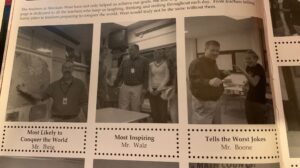By Andrew Lapin and Philissa Cramer

At Mankato West High school, Tim Walz and his social studies department colleague Bob Ihrig were both beloved by students at Mankato West High School. (Courtesy Ihrig)
(JTA) — As Tim Walz was inveighing against trends in Holocaust education in his 2001 master’s thesis, the high school where he worked was employing one of those methods: a “game” that, by today’s standards, would repel almost every expert in the field.
A fellow teacher divided his class into halves: Some would have to wear yellow stars and play “Jews,” while the others would play the part of Gestapo officers charged with tormenting them.
A Jewish former student who was disturbed by the activity told the Jewish Telegraphic Agency last week that Walz had stepped in to stop the game after her father complained. But her father, Stewart Ross, subsequently told JTA that he did not recall anything beyond his daughter’s distress.
Bob Ihrig, the teacher who led the Gestapo activity, and John Barnett, Mankato West’s principal from the time, also told JTA that they did not recall such an incident. But Ihrig said Walz, now the Democratic candidate for vice president, had been aware of the activity.
“When students start wearing stars, walking down the hall, they go from my classroom down the hall past Tim’s classroom,” he said. “There’s no way that you could avoid that.”
What is certain is that in another context, Walz had cautioned against exercises like the one Ihrig used, which was called the “Gestapo Game” and was a trademarked activity conducted in settings around the world. In his thesis for his master’s degree in experiential education at Minnesota State University, Mankato, which argued for changes to Holocaust education, Walz noted that researchers had “deemed counterproductive” activities in which students were asked to play roles from the Holocaust.
“Trying to simulate the conditions that victims of the Holocaust experienced was absurd,” Walz wrote. “The result on student learning was a trivialization of the horrors experienced during the Holocaust.”
Walz was not alone in objecting to the game: The activity championed by Ihrig is anathema in the field of Holocaust education today. Yad Vashem, Israel’s Holocaust memorial; the U.S. Holocaust Memorial Museum; and the Anti-Defamation League all warn against Holocaust role plays.
“Even when great care is taken to prepare a class for such an activity, simulating experiences from the Holocaust remains pedagogically unsound,” the U.S. museum says on its website. “The activity may engage students, but they often forget the purpose of the lesson and, even worse, they are left with the impression that they now know what it was like to suffer or even to participate during the Holocaust.”
Walz completed his thesis at the same time that Agustin recalls being in Ihrig’s class. The thesis reflected a longstanding interest in teaching about Holocaust and genocide that predated Walz’s years at Mankato West and extended into his current tenure as Minnesota’s governor.
Walz’s thesis argued that schools would do better to remove teaching about the Holocaust from units about World War II and instead situate it within instruction about genocides and human rights. That way, he said, students could understand the root causes of the violence with the aims of preventing future genocides.
The belief appeared to be long-held. Walz had previously taught about the Holocaust and other genocides in an early teaching role in Alliance, Nebraska. There, after studying the Holocaust as one of several genocides, his class accurately predicted that Rwanda was the most likely place for a future genocide to take place; one unfolded there the following year.
But Walz did not discuss his outlook on Holocaust education with some of his closest colleagues, several of them told JTA. Ihrig and Mike Sipe, another teacher who was also Mankato West’s wrestling coach, both said they had been surprised to learn last week that Walz had written a thesis about Holocaust education while they worked with him. They noted that completing a master’s degree conferred benefits including a pay raise and did not always reflect a teacher’s core interests.
Both recalled Walz as an inspiring teacher and good colleague who participated in the collaboration that took place informally in their department. (The student yearbook named Walz “Most Inspiring” the same year it called Ihrig “Most Likely to Conquer the World.”) Ihrig said Walz had been “encouraging” and “inquisitive” about the Holocaust activity, showing curiosity about elements of the exercise — which Ihrig recalls as a highlight of his teaching career more than a decade after he retired.
Ihrig said he first encountered the activity in a catalog for teachers in the late 1970s — making him one of thousands to purchase Rabbi Raymond Zwerin’s Gestapo game since its release in 1976.
Zwerin, a congregational rabbi in Denver who was married to a Holocaust survivor, designed the game in response to clamor from classroom educators for more engaging curriculum materials about the Holocaust, according to a 2022 story in the Forward. He told the news outlet that the game was meant to illustrate the role that luck — mazel, in Yiddish — played in survival.
“I think about my wife’s situation. Her parents were killed, her sister was killed, and she escapes,” he said. “Somebody found her on the street, as a little kid, and got her to the right ship at the right time. Total mazel.”
Zwerin’s game landed in a receptive climate. An explosion of interest in the Holocaust had generated an NBC miniseries, best-selling books and courses in high schools and colleges across the country. Simulation activities abounded: A made-for-TV movie released in 1981, “The Wave,” dramatized a classroom activity that turned students against each other without ever mentioning the Holocaust. Even some Jewish schools and camps engaged in simulations, with one boasting the slogan “Creative camping personalizes the Holocaust,” according to a 1980 New York Times story about the growing popularity of Holocaust narratives.
But qualms were already emerging. The Times story reported that Elie Wiesel, the survivor and novelist who became the face of Holocaust memory and would later win a Nobel Prize, was “appalled by the fact that well-meaning teachers think they have conveyed the meaning of the Holocaust to children by locking them in small rooms to simulate gas chambers” — a move that he traced to the NBC miniseries. “When he asked one teacher why she used simulation techniques,” the newspaper reported, “he was told, ‘If NBC could do it, if they could create fake gas chambers for their audience, why can’t we do it for children?’”
Ihrig’s classroom was never made to resemble a gas chamber. But the Gestapo activity morphed and expanded as generations of Mankato West students experienced it, Ihrig said. Students suggested that some of them act as the Gestapo. The stars, he said, were his own innovation. So was the decision to have the activity extend beyond his classroom walls.
“I wanted the students to understand that the Jewish people didn’t stop being a Jew and stop being persecuted, that it was a constant 24/7,” he told JTA. “It was too easy for these students, when the bell rang at the end of the period, to pick up and leave and life was back to normal. And so I wanted that stress, that tension, that experience, to last longer.”
But “Gestapo” students started harassing the “Jewish” ones in uncomfortable ways, Ihrig recalled, including in the bathrooms. The escalation was problematic but also instructive, he said.
“They hadn’t been coached, they hadn’t been taught. They took this upon themselves,” he said. “Probably 95% of the students were just totally compliant and obedient, which is exactly what happened in Nazi Germany.”
Holocaust educators today say there are far better ways to teach that lesson: through survivor testimonies, by examining primary source materials and by learning about psychology and human behavior. They say role plays serve to traumatize students and trivialize the experiences of survivors and victims while not teaching anything about history.
“In the Holocaust education field, it’s universally frowned upon in the strongest way — role plays are inappropriate — and I think we’ve done a good job. All the organizations are communicating that to teachers,” said Deborah Lauter, executive director of the Olga Lengyel Institute for Holocaust Studies and Human Rights.
“Today it would not be seen as common,” Lauter added. “It happens once in a while, and it’s shut down pretty quickly.”
A Florida middle school was inundated with criticism in 2006 after dividing students between the “privileged” and “persecuted” groups as part of a unit that included reading “The Diary of Anne Frank”; according to the ADL, one student told his parents, “The only thing I learned today is that I don’t want to be Jewish.”
A 2015 article in an Indiana newspaper described a one-day simulation participated in by teachers and students alike — and where the teacher who had conducted the activity for over a decade said he was increasingly having to combat Holocaust denial among his students.
Sipe, who still teaches at Mankato West, says there are no longer Holocaust simulations conducted in history classes there.
“I certainly don’t think it’s something that should be part of public education today,” he said. “No, the activity is certainly not part of something we do anymore.”
Ihrig said he understood that times have changed and that many would see the simulation as “traumatizing” today. But he also recalled years of positive feedback about the Gestapo activity that he said had predated Agustin’s experience, and followed it.
“I had a mother who was a school board member who talked to me and said, ‘You know, this was really emotionally draining for my daughter, and she’d come home at the end of each day and all of the stress and tension,’ because I told the students that, you know, you take this seriously, it’s going to have an impact on you,” Ihrig said. “And she said, ‘You know, that was really difficult to deal with in the week before vacation break,’ but she says, ‘I’m glad that you did that for my daughter and other students, because they needed that experience.’”



